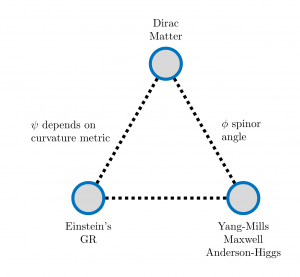Theory of Geometric Unity: Difference between revisions
(Added GU triangle image) |
(Symmetric -> Antisymmetric) |
||
| Line 21: | Line 21: | ||
|- | |- | ||
| '''3.''' Matter | | '''3.''' Matter | ||
Antisymmetric, therefore light has mass | |||
| <math>\partial_A \psi = m \psi</math> | | <math>\partial_A \psi = m \psi</math> | ||
|} | |} | ||
Revision as of 17:12, 8 April 2020
See also: https://theportal.wiki/wiki/A_Portal_Special_Presentation-_Geometric_Unity:_A_First_Look
First Presentation
Annotations
Background
3 insights by Ed Witten
| 1. The Arena ([math]\displaystyle{ Xg_{\mu\nu} }[/math]) | [math]\displaystyle{ R_{\mu\nu} - \frac{1}{4} Sg_{\mu\nu} + \Lambda g_{\mu\nu} = \left( \frac{1}{c^4} 8\pi GT_{\mu\nu}\right) }[/math]
[math]\displaystyle{ S }[/math] - Scalar curvature, Einstein's notation. |
| 2. [math]\displaystyle{ G }[/math] (non abelian)
[math]\displaystyle{ SU(3) \times SU(2) \times U(1) }[/math] |
[math]\displaystyle{ d_A^*F_A=J(\psi) }[/math] |
| 3. Matter
Antisymmetric, therefore light has mass |
[math]\displaystyle{ \partial_A \psi = m \psi }[/math] |
Frequently Asked Questions
Please help answer these questions!
What will this theory predict?
When will Eric release the next part?
Why hasn't Eric gone through the normal scientific route? Arxiv.org? Academic journals?
Related existing theories
Causal Fermion Systems: [1]

